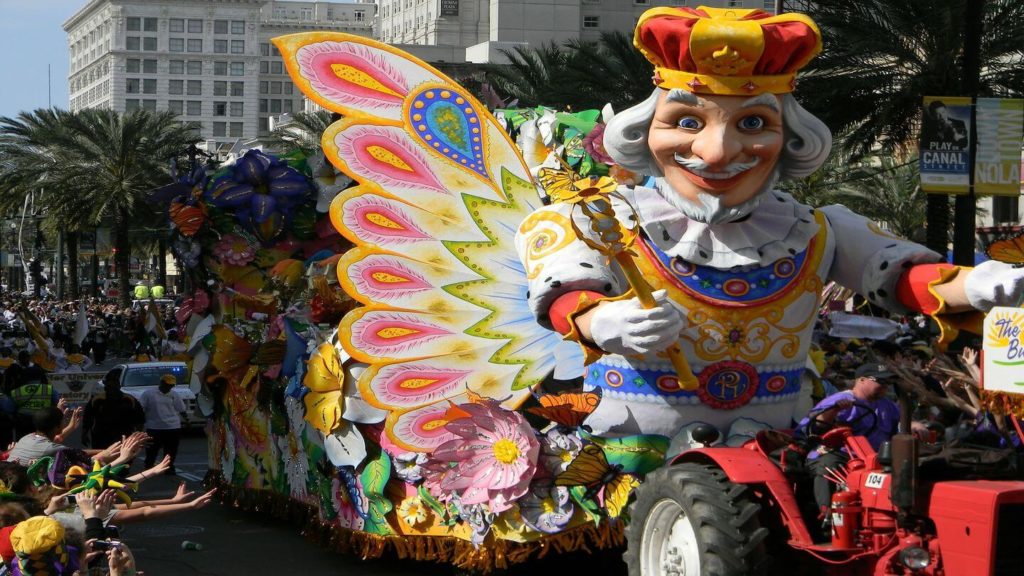Recently updated on March 3rd, 2025 at 10:55 am
Once a year during Mardis Gras, New Orleans transforms into a colourful flurry of parades, picnics, music, crowds and crazy costumes. Around 1.4 million people descend on the city for the iconic festivities that celebrate Fat Tuesday. It’s a time for indulgence and excitement, and nowhere does Mardis Gras quite like New Orleans. In 2020, the celebration will take place on 25 February, so here’s everything you need to know about the unique history of Mardis Gras.
The origins of Mardis Gras


Mardis Gras is believed to have originated in medieval Europe, with Carnival celebrations starting in Rome and Venice in the 17th and 18th centuries. It traditionally took place on Fat Tuesday, the Christian feast period before Ash Wednesday and the start of Lent, a six-week-long fast observed before Easter. The celebration spread to France where it was originally called “Boeuf Gras”, before arriving in the French colonies like New Orleans, Louisiana.
The history of Mardis Gras in New Orleans can be traced back to 3 March 1699, when French explorers Pierre Le Moyne d’Iberville and Sieur de Bienville arrived near present-day New Orleans. When they realised it was the eve of the medieval carnival, they held a small celebration and declared their landing spot “Pointe du Mardi Gras”.
In 1718, the French had established the city of New Orleans near the land known as “Pointe du Mardi Gras”. By the 1730s, the parades, lavish dinners and masquerade balls of Mardis Gras became an annual tradition in the city.
The Mardis Gras festivities continued in New Orleans until the Spanish took control of the city in 1762. They banned the debaucherous rituals of Mardis Gras and the bans were only lifted once Louisiana became a US state in 1812.
RELATED CONTENT: Seven colourful festivals around the world
The history of Mardis Gras in New Orleans


On Mardis Gras in 1827, a group of students danced through the streets wearing bright costumes. They wanted to bring the rowdy festivities they’d seen in Paris on Mardis Gras. The first recorded New Orleans Mardis Gras parade took place ten years later in 1837. Since then, the carnival continues to this day. It’s even a state holiday in Louisiana and they’re the only US state to make it a legal holiday.
Over the years, the New Orleans Mardis Gras traditions began to evolve into what we know today. Crowds of masked revellers paraded through the streets, riding horseback, pulling carriages and carrying gaslight torches.
The first Mardis Gras krewe formed in 1856. Known as the Mistick Krewe of Comus, they organised incredible rolling floats, marching bands and masked balls. The second Mardis Grewe formed 14 years later in 1870. They were called the Twelfth Night Revelers and were the first to introduce the historic Mardis Gras “throws”.
In 1872, the Russian Grand Duke Alexis Romanoff visited New Orleans. A group of local businessmen organised the first Mardis Gras daytime parade, to entertain the Grand Duke and the citizens of New Orleans. It was lead by Rex, the “King of Carnival”, in honour of the Grand Duke. Since then, krewes have remained an iconic part of the Mardis Gras festivities in New Orleans.
GET INSPIRED BY: Tastes and Sounds of the South
Traditions of Mardis Gras New Orleans
The traditional colours


The history of Mardis Gras’ traditional colours began when the Russian Grand Duke visited New Orleans. The Krewe of Rex wore the Grand Duke’s family colours – green, gold and purple – in honour of his arrival.
The Grand Duke’s welcoming committee also handed out green, gold and purple beads to the party-goers. They remain the iconic colours of Mardis Gras today and have been given meanings: green for faith, gold for power, and purple for justice.
The King Cake
The King Cake is a traditional dessert made for Mardis Gras. The origins of the cake date back to medieval times, when European cultures celebrated the 12th day of Christmas with sweets and gifts. In the bible, the kings of the time would have visited the newborn Jesus, bringing sweets and gifts of their own, and that’s why the cake is called King Cake.
Today, the King Cakes are doughy, fried and frosted pastries, made in the traditional Mardis Gras colours. They’re also circular and braided to represent a King’s crown, and baked with a baby figurine inside. Whoever finds the baby, must host the next party!
The Krewes


Today there are more than 70 secret societies, or krewes, that take part in Mardis Gras celebrations. The krewes build floats around their theme and roll down the streets on parade days. They sometimes even feature a celebrity guest to entertain the crowds.
The ‘throws’
Each float famously gives out “throws”, or party favours, to the crowd. The throws range from the gold coins given by the Krewe of Rex, to the coconuts given by the Krewe of Zulu. Almost everyone also throws colourful beads. It’s a great honour to receive a throw, and the traditional way of asking for throws is to shout “Throw me something, mister”. Remember to bring a big bag so you can haul away all the trinkets you catch from the floats!
Where will you celebrate Mardis Gras this year? Let us know in the comments below…